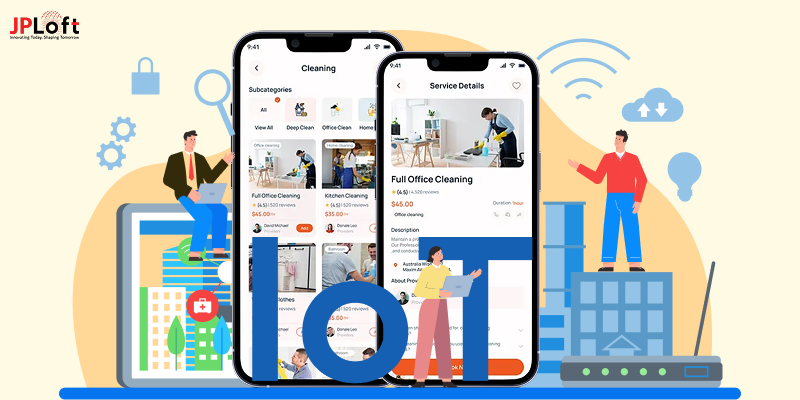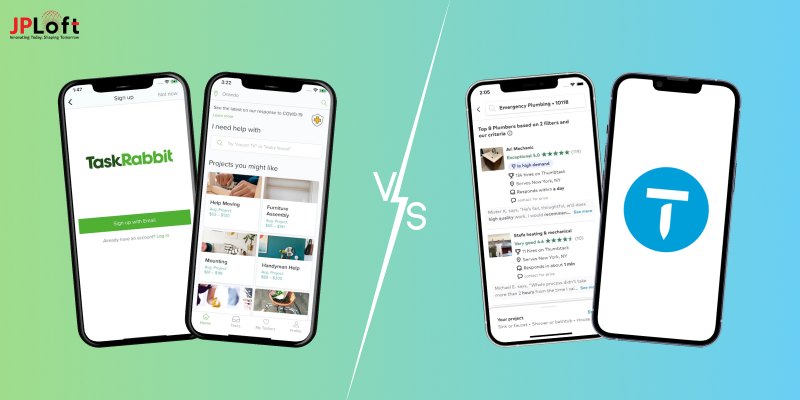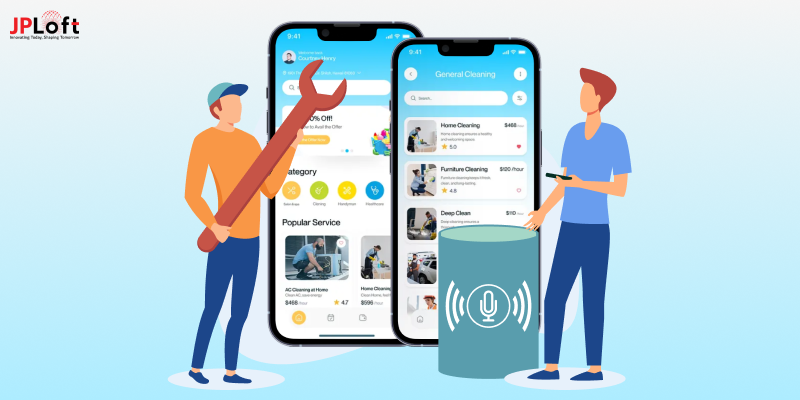Are you the one looking forward to hiring handyman app developers, but confused about their cost or the price?
Well, it happens when you start to build your own dream app.
As entrepreneur Chris Grosser once said, “Opportunities don’t happen. You create them.” This quote perfectly applies here because hiring the right developers is about creating opportunities for your business rather than just cutting costs.
When it comes to building a successful on-demand handyman app, one question often takes center stage: What’s the cost to hire handyman app developers?
Well, the cost to hire a handyman app developer lies between $20 and $180/hour. It depends on multiple factors like expertise, features, and timelines. The investment isn’t only financial, it’s about choosing skilled professionals who understand app architecture, user needs, and future scalability.
A well-developed handyman app can become the backbone of your service business, streamlining bookings, payments, and customer communication.
In this blog, we’ll break down the critical considerations that influence hiring decisions, explain where your money truly adds value, and guide you toward making informed choices that set your app apart in a competitive market.
Are you ready to begin?
Then, let’s proceed together.
Key Takeaways
The cost to hire handyman app developers ranges between $20 to $180/hour; define the scope early to manage budgets and timelines effectively.
Choosing the right hiring model, such as freelancer, agency, or dedicated team, helps balance cost, speed, and long-term scalability.
Building a true MVP first minimizes risk, validates demand, and prevents overspending on features users may not need.
Leveraging cross-platform frameworks accelerates launch, while reserving native specialists ensures smooth handling of heavy mapping and real-time tracking features.
Strong focus on security and compliance with PCI standards, encryption, and data handling reduces risk and future rework.
Streamlined QA, automation, and continuous delivery lower development errors and speed up release cycles.
Learning About The Handyman App Development
When creating a handyman app, cost matters. However, before this, it is essential to learn a brief on the same.
When you create such an app, it involves designing and building a two-sided marketplace application. Here, the homeowners can book local pros for different jobs such as electrical, plumbing, assembly, and painting.
So, how can you develop a dream handyman app?
It is a complete process that all begins with analyzing the current market study and ends with the launch. Let’s consider a brief below.
-
Market Research: This step is all about evaluating the current users’ preferences. Here, it's all about identifying the present market and learning its core needs in detail.
-
Building an MVP: Selecting features and preparing for launching an MVP helps to identify any errors that might impact the brand’s value in the diversified market.
-
Developing the Complete App: It's all about designing and including a technology stack for building the complete app.
-
Testing the App: After development, each function is tested broadly.
-
Launch and Maintenance: Now, it's crucial to launch the app in the defined market. Along with this, proceed with complete app maintenance landscape.
One of the important points to note here is to hire a dedicated developer to convert your dream app into reality.
Now, let’s proceed with the different types of handyman app developers to hire in the following section.
Types of Handyman App Developers to Hire
Discussing the diversified types of handyman app developers will help you to identify which one to hire as per your comfort, budget, and dream app.
Let’s learn about the diversified types below.
A] Freelancers
Independent developers you hire for a fixed scope. Well-suited for bounded tasks such as chat, push notifications, map refining, payment bug fixes, or UI adjustments.
You are responsible for planning, code reviews, testing, and releases. The benefits are quick onboarding and elastic cost. Drawbacks are unpredictable availability and knowledge walking away after the delivery.
Reduce the risks through the use of milestone-based agreements, ownership of the code in your repositories, requesting test coverage, and requesting a short handover video along with documentation. Here, the cost to hire handyman developers will depend on factors such as scope clarity, seniority, time zone, etc.
Cost to hire: Freelancer $20 to $75 per hour.
B] In-house Developers
In-house full-time employees on your payroll. Ideal when anticipating a long road map and regular iteration of pricing rules, dispatch logic, service areas, and admin tools.
You get quick feedback cycles with design and support, and complete control of priorities and security. The cost will depend on skills, location, tech stack, and engagement.
It is more expensive due to salaries and benefits, and the amount of time it takes to hire. Establish standards early with coding standards, automated tests, continuous delivery, and explicit on-call responsibilities.
Cost to hire: $45–$90 per hour
C] Dedicated Remote Developers Via a Vendor
Full-time contributors who work solely on your app, while the vendor is responsible for hiring, payroll, and replacement.
Well-suited when you want consistent velocity across iOS, Android, backend, or quality assurance without creating a full-fledged HR organization. Similarly, here the factors that depend on the cost to hire dedicated developers are skills, location, scope clarity, and tech stack.
You still control the day-to-day work. Safeguard your interests with code ownership clauses, replacement service levels, and a few overlap hours for daily standups and reviews.
Cost to hire: $25 to $140 per hour.
D] Staff Augmentation
You bring in one to three experts to complement your current staff. Ideal for gaps in skills like payouts and payments, real-time tracking, scheduling engines, or automated testing.
You have product and architecture ownership while the staffed engineers deliver sprints. Here, the cost will depend on factors such as scope size, location, seniority, and tech stack.
Define simple acceptance criteria, establish test coverage goals for bookings and payments flows, and operate a deterministic release schedule. Staff augmentation services do comprise hiring external talent that further helps to supplement the existing company’s workforce.
Cost to hire: 80 to 200 dollars per hour
E] Full-Service Agency
A more extensive team that encompasses everything from product management and design to iOS, Android, web, backend, DevOps, and compliance.
Optimal for multi-city launches, identity verification, insurance documents, and support service level agreements. Cost-influencing factors are seniority, location, feature scope, and engagement model.
Coordination is simpler with one partner handling the entire stack through professional mobile app development services in the USA. While higher costs may be expected, weekly demos, security audits, time tracking, and clear intellectual property ownership in your contract ensure transparency and reliability.
Cost to hire: The estimated cost per hour lies between 100 and 200 USD
F] Offshore Team
Developers in far-flung time zones. You can stretch the budget and staff rapidly. Best used when you have sound specifications, good automated testing, and solid product leadership.
Schedule a daily overlap window for standups and reviews. Here, the cost drivers comprise the region, stack, scope, and seniority.
Screen for English fluency, security best practices, and marketplace experience. Begin with a short trial sprint before committing.
Cost to hire: $20–$60 per hour
G] Nearshore Team
Developers in a close time zone. Collaboration is easier, workshops are simpler to schedule, and hotfixes move faster than with distant time zones.
Costs often sit between offshore and onshore. Good fit for continuous experiments in routing accuracy, price experimentation, and pro incentives.
The different cost drivers include scope, tech stack, location, and seniority.
Cost to hire: $35 to $90 per hour
H] Onshore Team
Developers in your own country. Easiest to work together and quickest to clarify requirements.
Best option if you have complicated compliance, complicated enterprise integrations, or strict legal restrictions. Similarly, the cost drivers for the onshore team include location, tech stack, engagement model, and the skills of the experts in the team.
You still require the same engineering fundamentals, such as automated tests and continuous delivery, to maintain quality consistency. The top mobile app development company knows well how to make your app a success.
Cost to hire: USD 120 to 180 per hour
I] Hybrid Model
Keep product leadership, user experience, security, and quality assurance in-house. Outsource the build lanes to a third party.
This keeps core knowledge safe while providing you with burst capacity. Apply shared repositories, one continuous delivery pipeline, and written interface contracts between mobile and backend. Factors impacting this cost are location, seniority, engagement model, and scope of the project.
Design knowledge transfer from the beginning with documentation and shadowing. The different cost drivers are seniority, location, tech stack, and engagement model.
Cost to hire: $40 to $110 per hour
|
Type |
Definition |
Pros |
Risks |
Best For |
|
Freelancers |
Independent developers hired per project or task. |
Quick onboarding, flexible cost, good for small fixes. |
Unpredictable availability, risk of losing knowledge post-delivery. |
Small tasks (UI tweaks, bug fixes, chat, maps). |
|
In-house Developers |
Full-time employees on your payroll. |
Full control, quick feedback loops, better security. |
High cost (salaries + benefits), slow hiring process. |
Long-term roadmap, frequent updates, enterprise-grade apps. |
|
Dedicated Remote Developers (via Vendor) |
Full-time devs managed by a vendor but working solely on your app. |
Consistent velocity, vendor handles payroll/replacements. |
Still need strong oversight, cost varies widely. |
Mid-to-large projects, ongoing development cycles. |
|
Staff Augmentation |
Adding external experts to support your existing team. |
Fill skill gaps quickly, ownership stays with you. |
Costs can be high, requires solid product management. |
Specialized needs (payments, real-time tracking). |
|
Full-Service Agency |
Agency team handling design, dev, QA, DevOps, compliance. |
End-to-end service, simpler coordination, professional mobile app development services. |
Higher costs, dependency on one vendor. |
Complex apps, multi-platform launches, high compliance needs. |
|
Offshore Team |
Developers located in distant time zones. |
Budget-friendly, quick scaling. |
Time zone issues, possible communication gaps. |
Well-defined specs, automated testing setup. |
|
Nearshore Team |
Developers in nearby time zones. |
Easier collaboration, faster hotfixes. |
Costlier than offshore, but cheaper than onshore. |
Continuous experiments, quicker response needs. |
|
Onshore Team |
Developers in your own country. |
Easy collaboration, legal & compliance alignment. |
Highest hourly rates. |
Strict compliance, enterprise integrations. |
|
Hybrid Model |
Mix of in-house leadership and outsourced development. |
Keeps core knowledge internal, adds burst capacity. |
Requires strong coordination and knowledge transfer. |
Balanced approach—secure, scalable, cost-optimized. |
Now, proceeding with the types, let's evaluate the complete cost to hire a handyman app developer in the next section. The mobile app development company
Cost to Hire Handyman App Developers
The price to engage handyman app developers is usually between $20 and $180 an hour, depending on location, experience, and engagement model. Offshore and nearshore solo contributors tend to gravitate towards $20 to $60 an hour.
Seasoned cross-platform or native leads tend to be between $60 and $120 an hour. Onshore agencies and specialty experts can command up to $120 to $180 an hour. Stack and scope count.
Customer and pro apps, real-time maps, payments, scheduling, and an admin portal add cost and complexity. As a rough frame, an MVP with one cross-platform developer and one backend developer for ten weeks at thirty hours each is approximately six hundred hours. Hire mobile app developers and evaluate the right process to build your dream app within your budget.
At $40 to $80 per hour, that is approximately $24,000 to $48,000 before design, QA, and DevOps. Allow buffer for testing and after launch fixes.
Let’s evaluate the complete list of factors impacting the cost to hire handyman app developers in the section below.
Factors Affecting the Cost to Hire a Handyman App Developer
While starting an online handyman business, one of the factors that impacts the most is cost. It becomes crucial to evaluate the handyman app developer's cost when deciding the budget.
And, for the cost, it's significant to know the details about factors impacting the same. Let’s get ahead and discover more.
1. Feature Depth and Scope
More developer features equate to more hours and senior skills. An MVP for job posting, quotes, booking, and simple payments can incorporate generalists. Handyman app features include service booking, browsing, and many advanced features. The complexity of features depends on the diversity of the app, its size, etc.
Throw live ETAs, complex dispatch rules, surge prices, warranties, dispute processes, or offline support into the mix, and you will require map, scheduling, and fintech specialists. Manage scope with a must-have list and phase nice-to-haves after release.
2. Tech Stack and Platforms
Cross-platform saves time for iOS and Android with a shared codebase. Under the handyman app tech stack, it provides dual native, providing improved performance for heavy maps, background tracking, and device-specific functionality. There's almost always a web admin needed.
Opt for cross-platform for velocity, then save native experts for mapping or battery-sensitive tracking. You can publish your handyman app on the iOS store or the Android store, depending on the target audience’s requirements.
3. Seniority and Specialization
Juniors are cheaper per hour but require supervision and generate more review cycles. Seniors and experts send faster, take care of edge cases in dispatch and payouts, and minimize rework.
A good balance is to have one senior over two mids, with good code review guidelines. P
4. Location and Time Zone
Offshore is cost-effective but requires solid specs and daily overlap. Nearshore strikes a balance between cost and teamwork.
Onshore is expensive but ideal for quick workshops, compliance, and enterprise integrations. Guard quality with written acceptance criteria and brief daily standups.
5. Hiring Model
Freelancers are best suited for small, sharply defined work. On-demand remote developers provide consistent speed without establishing HR.
Boutique shops own MVP from start to finish with design, mobile, backend, and QA. Full-service firms manage multi-city rollouts and sophisticated compliance.
Hybrid maintains product and QA leadership internally while delegating build lanes.
6. Timeline and Urgency
Fixed dates increase cost. Teams introduce overtime, parallel development, and risk buffers.
Reduce feedback loops with weekly demos, scope freeze early, and have one decision maker on your side.
7. Compliance, Security, and Data Handling
KYC, document storage, payouts, tax invoices, and protection of personal data need experienced engineers.
Include data retention rules, encryption, role-based access, and call masking. Utilize well-known providers to minimize custom work and audit time.
8. QA Depth and Automation
Manual testing is less expensive but slower and lacks regression. Automation for booking, payments, chat, and maps minimizes post-launch fixes.
A device matrix and a small set of end-to-end tests cost themselves back rapidly.
9. Third-party Integrations
Payments and split payouts, KYC, maps and routing, chat, notifications, analytics, and address validation all increase complexity.
Fewer vendors = quicker delivery. Choose providers with robust SDKs, good docs, and sandbox support.
10. Product Clarity and Discovery
Poor briefs lead to rework. A week-long discovery with user stories, acceptance criteria, flow maps, and a clickable prototype saves hundreds of hours of development and QA.
11. Design and Accessibility Level
A handyman app design system is quick to construct. Custom animations, intricate states, and extensive accessibility support take time but enhance retention. Lock down the design system early to prevent churn.
12. DevOps and Observability
Staging environments, CI or CD, logs, metrics, alerts, and backups keep releases safe and quicker. Managed services eliminate setup effort and maintenance overhead.
|
Factor |
Impacts |
Typical hourly cost band in USD |
|
Scope and feature depth |
MVP vs complex dispatch, ETAs, disputes, warranties |
$30 to $160 |
|
Platforms and stack |
Cross-platform for speed, native for heavy maps or tracking |
$30 to $150 |
|
Seniority and specialization |
Junior to specialist for routing, payouts, and fraud |
$20 to $180 |
|
Location and time zone |
Offshore, nearshore, and onshore collaboration needs |
$20 to $180 |
|
Hiring model |
Freelancer, dedicated remote, studio, agency, hybrid |
$20 to $180 |
|
Timeline and urgency |
Standard schedule vs rush premium |
Base plus 10 to 30 percent |
|
Compliance and security |
KYC, documents, PII encryption, audits |
$60 to $180 |
|
QA depth and automation |
Manual vs automation and device farms |
$20 to $120 |
|
Third-party integrations |
Payments, KYC, maps, analytics, messaging |
$40 to $150 |
|
Product discovery |
Briefs, user stories, prototype fidelity |
$30 to $120 |
|
Design and accessibility |
Basic system vs custom visuals and full accessibility |
$30 to $120 |
|
DevOps and observability |
CI or CD, staging, monitoring, backups |
$40 to $120 |
Tips to Reduce the Cost of Hiring an App Developer
When it comes to the top handyman apps, it's essential to stand out from this competition. Hiring the right app developer can help you; however, what if you reduce the cost of hiring an app developer?
Following the right tips will help estimate the average cost to hire an app developer; hence, let’s learn them all below.
1) Lock the Scope Early
Write acceptance criteria and user stories before development begins. There are fewer rewrites with fewer unknowns. Leave must-haves in the first release and save nice-to-haves for the future.
Insert a short discovery sprint to prototype high-risk flows. Document what is out of scope so that changes initiate an explicit decision.
2) Build a True MVP
Ship the minimum viable set of features that demonstrates value. Prioritize core flows such as sign up, job post, schedule, pay, and review. Introduce advanced reporting and automations only once you see momentum.
Launch in a single city or a limited user segment initially. Measure a single success metric so effort remains focused.
3) Leverage What Already Exists
Opt for cross-platform on mobile when performance is feasible. Employed tried libraries, payment SDKs, map solutions, and auth libraries. Reusing tried parts saves weeks and minimizes bugs.
Select vendors with clear docs and sandbox access. Review usage limits and pricing early to prevent surprises.
4) Select the Correct Mix of Team
Utilize one senior to mentor two mid-level engineers rather than three seniors. Mix nearshore and offshore engineers for common tasks. Maintain product and QA leadership in proximity to your time zone.
Use specialists just for brief spikes such as dispatch or payouts. Document major decisions in order to avoid backtracking.
5) Insist on Visible Milestones
Request weekly demos, a release schedule, and code in your repository from day one. Make payments contingent upon demoed results. Early visibility catches scope creep before it burns money.
Request a plain burn-up chart and a rolling risk list. Demand brief release notes after each sprint.
6) Automate the Mundane but Costly Stuff
Implement ongoing delivery, fundamental test suites, and a device matrix on day one. Automated validation on booking, payment, and login avoids expensive late-stage fixes.
Include linting and pre-commit hooks to keep the code tidy. Measure defect escape rate to demonstrate automation is proving its worth.
Points to Consider Before Hiring Handyman App Developers
When hiring handyman app developers, focus on their industry experience, portfolio quality, and ability to build scalable apps.
Check if they understand features like booking, payments, and user management, and ensure they follow best practices for security and performance.
Let’s discuss the complete points to consider before hiring handyman app developers.
► Define scope and success
First, write the exact flows you require for the first job post, quote, schedule, track, pay, and review. Clear scope controls timelines, bugs, and costs to hire handyman app developers. Park must-haves for MVP and prioritize nice-to-haves for later.
► Choose the Right Hiring Model
Choose between in-house, staff augmentation, boutique studio, or freelancers. All balance risk, speed, and cost of hiring developers. If you do not have product leadership, use a studio or an augmented pod instead of solo freelancers.
► Verify Actual Marketplace Experience
Request live links and code samples for booking or on-demand apps. Verify activity on maps, ETAs, payouts, and disputes. Seniority influences the cost to hire handyman app developers but lowers rework later.
► Verify Security, Payments, and Compliance
You will be dealing with KYC, documents, payouts, refunds, and tax invoices. Shortlist teams familiar with PCI fundamentals, secure storage, and audit trails. Be prepared to pay more to hire developers with specialties here, and it is worth it.
► Require a Delivery Process and QA Plan
Request weekly demos, acceptance criteria, device matrix, and fundamental automation for bookings and payments. Good process reduces fail rates and surprises. Good QA reduces the overall cost to hire developers by avoiding post-launch fire drills.
► Lock Contracts, IP, and Support Early
Own the design files, code, and repo. Establish SLAs, hotfix windows, and handover. Have a clear rate card for roles so you can model the cost to hire app developers based on changing needs.
Hire Experts from JPLoft to Create Your Handyman App
The cost to hire handyman app developers varies based on project complexity, technology stack, and the level of expertise in the team you select.
Rather than letting hourly charges or fixed budgets be your priority, the most significant factor to consider is the value developers contribute to your project.
Collaborating with a seasoned Handyman App Development Company like JPLoft guarantees that you are provided with start-to-finish service, from planning and design to integrating features and maintenance after launch.
JPLoft has expertise in developing scalable apps with core functionalities such as managing bookings, secure payment, and live communication. By cooperating with the appropriate developers, you not only receive technical knowledge but also market trends and user expectations insights, which make your app future-proof and competitive.
Conclusion
Hiring handyman app developers is not just about comparing hourly rates; it’s about investing in expertise that ensures long-term growth.
A well-chosen development team can help you build a feature-rich, scalable app that keeps users engaged, streamlines bookings, and strengthens your brand’s presence in the on-demand economy.
By carefully evaluating hiring models, verifying security expertise, and prioritizing a clear development process, you set your project on the path to success. Partnering with a trusted company like JPLoft gives you the advantage of proven experience and market insights, making your app future-ready and competitive.
FAQs
The cost usually falls between $20 and $180 an hour, depending on developer expertise, location, and the hiring model you choose.
Freelancers are flexible for small fixes, while dedicated teams or agencies are better for complex, scalable apps with ongoing needs.
Key factors include project scope, tech stack, developer seniority, compliance requirements, and whether you hire offshore, nearshore, or onshore.
Freelancers cost less but require more oversight. A full-service company provides end-to-end support, reliable delivery, and long-term scalability.
Check their portfolio, experience in on-demand apps, knowledge of security standards, and ability to deliver features like booking and payments.
You can cut costs by defining scope early, starting with an MVP, using cross-platform development, and working with experienced teams that avoid rework.





.webp)







Share this blog